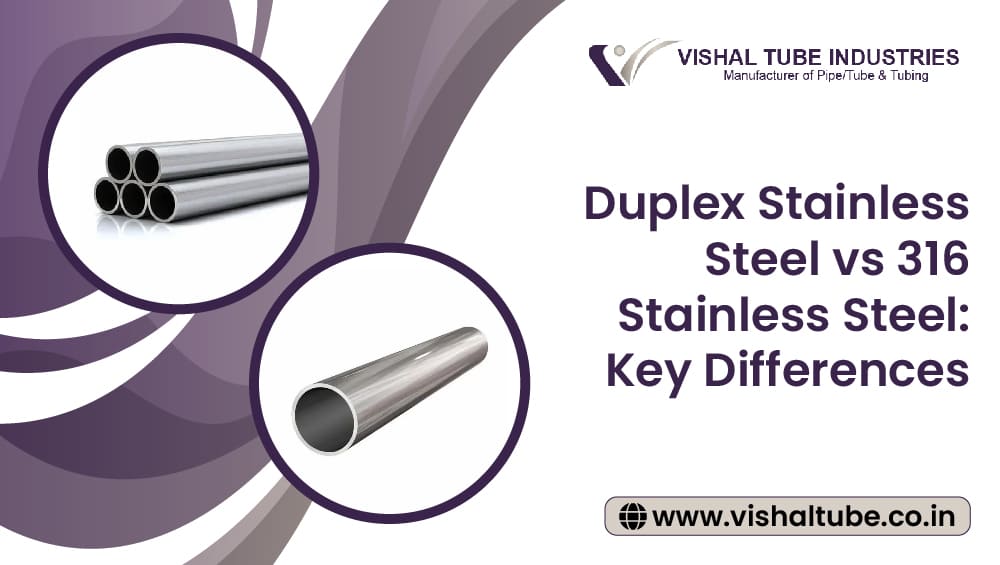When deciding on the right stainless-steel grade for a mission, the choice regularly narrows all the options down to typically used alternatives: duplex stainless-steel vs 316. While each offers wonderful corrosion resistance and electricity, they may no longer be created equal. Understanding the difference between duplex and 316 can assist engineers, fabricators, and clients in selecting the maximum cost-effective and high-performing uncooked material for their precise application.
In this blog, we’ll dive into the duplex vs 316 stainless steel evaluation, exploring their chemical composition, mechanical properties, corrosion resistance, and wonderful uses of — assisting you’re making a smart, informed decision.
What is 316 Stainless Steel?
316 Stainless Steel, furthermore called SS316, is an austenitic stainless steel that includes high degrees of chromium (16–18%), nickel (10–14%), and a critical addition — molybdenum (2–3%). The molybdenum raw material substantially complements its resistance to chloride-delivered corrosion, making it terrific for marine, chemical, and pharmaceutical environments.
Key Characteristics of SS316:
- Excellent resistance to pitting and crevice corrosion
- High ductility and longevity
- Good formability and weldability
- Non-magnetic in the annealed circumstance
What is Duplex Stainless Steel?
Duplex stainless steel is a family of stainless steels that has a twin-phase microstructure, combining austenitic and ferritic levels. This shape gives it a very precise mixture of homes: the power of ferritic stainless steels and the corrosion resistance of austenitic grades like 316
.
There are numerous styles of duplex stainless steels, with 2205 being the most unusual grade. Typical composition includes about 22% chromium, 5–6% nickel, and 3% molybdenum.
Key Characteristics of Duplex Stainless Steel:
- Higher strength (about times that of 316)
- Excellent resistance to pressure corrosion cracking
- Better resistance to chloride corrosion
- Moderate weldability and real fatigue energy
Duplex vs 316 Stainless Steel: Side-by-Side Comparison
Let’s break down the duplex vs SS316 comparison across several critical factors:
1. Chemical Composition
| Element | 316 Stainless Steel | Duplex Stainless Steel (2205) |
| Chromium | 16–18% | 22–23% |
| Nickel | 10–14% | 5–6% |
| Molybdenum | 2–3% | 3–3.5% |
| Nitrogen | Trace | 0.14–0.2% |
Takeaway: Duplex steels contain more chromium and less nickel, resulting in enhanced corrosion resistance and lower material cost due to reduced nickel content.
2. Mechanical Strength
| Property | 316 Stainless Steel | Duplex Stainless Steel |
| Yield Strength (MPa) | ~290 | ~450–550 |
| Tensile Strength | ~580 MPa | ~700–900 MPa |
Takeaway: One of the most critical differences between duplex and 316 is electricity. Duplex stainless steel gives nearly double the electricity, making it fine for structural programs where weight loss is essential.
3. Corrosion Resistance
Both materials provide fantastic corrosion resistance, however, in particular environments.
316 SS plays quite well in acidic and chloride-rich environments.
Duplex SS offers higher resistance to chloride stress corrosion cracking and is extra suitable for high-strain environments.
Takeaway: In extensively aggressive chloride conditions, together with seawater or brine processing, duplex stainless steel outperforms 316.
4. Weldability
316 stainless steel is a lot less complex to weld and is an entire lot less vulnerable to thermal sensitivity or cracking.
Duplex stainless steel calls for additional welding sooner or later of welding to prevent phase imbalance and embrittlement.
Takeaway: For programs with exquisite welding, SS316 is probably greater individually-extremely good except proper duplex welding practices are accompanied.
5. Cost and Availability
Although duplex stainless-steel makes use of a terrific deal of less nickel (which lowers alloy cost), its manufacturing is more complicated and can be priced slightly higher than 316. However, its accelerated power and reduced weight can bring about significant economic and financial savings in fabrication and long-term overall performance.
Takeaway: While duplex can also have a better upfront cost, its common price in structural, good-sized common performance often justifies the funding.
Where is 316 Stainless Steel Used?
- Food and beverage processing gadget
- Marine environments (above the waterline)
- Chemical processing machine
- Pharmaceutical tanks and piping
- Heat exchangers
Where is Duplex Stainless Steel Used?
- Offshore oil and gasoline systems
- Seawater desalination plant life
- Structural additives in bridges and buildings
- Chemical storage tanks
- Paper and pulp processing
Choosing the Right Grade: Duplex vs SS316 Comparison Summary
| Feature | 316 Stainless Steel | Duplex Stainless Steel |
| Strength | Moderate | High |
| Corrosion Resistance | Excellent | Superior (especially SCC) |
| Weldability | Easier | Moderate |
| Cost | Lower upfront | Higher upfront, better ROI |
| Best Use Case | Moderate corrosion areas | High strength & chloride environments |
Why Choose Vishal Tubes for Your Stainless Steel Needs?
At Vishal Tube, we specialize in offering tailored stainless steel solutions throughout industries. Whether you’re seeking out modern-day 316 stainless-steel additives or superior duplex stainless steel grades, our group guarantees excellent, consistent, and timely transport. As experts in duplex vs 316 stainless steel average performance, we assist our customers in selecting the proper cloth primarily based on technical specifications and lengthy-time period cost.
What We Offer:
Wide inventory of duplex and austenitic stainless-steel grades
Precision slicing, fabrication, and custom answers
Competitive pricing with worldwide export functionality
Technical session for material choice
Final Thoughts
The duplex vs 316 stainless steel evaluation shows that each material includes big benefits depending on your application. If your assignment requires excessive electricity, advanced corrosion resistance, and decreased weight, duplex stainless steel is a smooth winner. On the other hand, for rate-powerful and without hassle fabricated solutions, SS316 stays reliable.
Still uncertain if this is right for your assignment? Reach out to Vishal Tube — your stainless steel partner — and allow us to help you make an excellent product choice.

